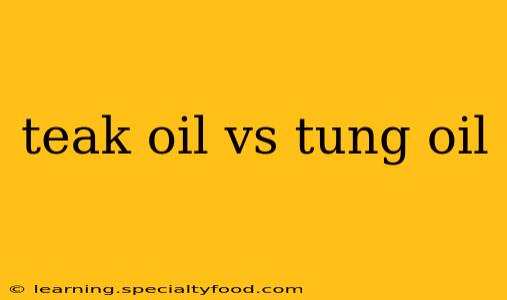Choosing the right oil for your wood finishing project can be daunting. Two popular choices often top the list: teak oil and tung oil. While both offer protection and enhance the beauty of wood, they have distinct differences in their properties, applications, and final results. This detailed comparison will help you decide which oil best suits your needs.
What is Teak Oil?
Teak oil isn't actually derived from teak trees. It's typically a blend of linseed oil, other drying oils, and solvents. The name is a bit of a misnomer, leveraging the popularity and perceived high quality associated with teak wood. This blend is designed to penetrate wood, providing water resistance and enhancing the natural color. It's often chosen for outdoor furniture and other items exposed to the elements.
What is Tung Oil?
Tung oil, on the other hand, is a true botanical oil extracted from the seeds of the tung tree. It's known for its durability, water resistance, and ability to create a hard, protective finish. Unlike teak oil's blend, tung oil is a single ingredient (though sometimes you'll find "standardized" tung oil blends that might include other ingredients). It offers excellent protection against UV damage and water absorption.
Teak Oil vs. Tung Oil: Key Differences
Here's a breakdown of the key differences between these two popular wood finishes:
Composition:
- Teak Oil: A blend of linseed oil, other drying oils, and solvents.
- Tung Oil: A 100% natural oil extracted from tung tree seeds (though some blends exist).
Drying Time:
- Teak Oil: Dries relatively quickly, often within a few hours.
- Tung Oil: Dries much slower, often taking days or even weeks to fully cure, depending on the environment and application.
Durability:
- Teak Oil: Provides moderate durability and water resistance, suitable for indoor or sheltered outdoor use. It requires more frequent reapplication compared to Tung oil.
- Tung Oil: Offers superior durability and water resistance, ideal for outdoor furniture and items subject to harsh conditions. The cured finish is harder and more protective.
Penetration:
- Teak Oil: Penetrates the wood fairly well, enhancing its natural color and grain.
- Tung Oil: Penetrates the wood well, though slower than teak oil. This deep penetration contributes to its superior protection.
Finish:
- Teak Oil: Produces a slightly softer, more easily scratched finish.
- Tung Oil: Creates a harder, more durable, and water-resistant finish.
Application:
- Teak Oil: Easy to apply and dries faster.
- Tung Oil: Requires more coats and more time for each coat to dry, making the application process more lengthy.
Cost:
- Teak Oil: Generally less expensive than pure tung oil.
- Tung Oil: Can be more expensive due to its pure botanical origins and longer application process.
Which Oil is Right for My Project?
The best choice depends on your specific needs and the type of project:
-
For outdoor furniture and high-traffic areas requiring maximum durability and water resistance: Tung oil is the better choice, despite its slower drying time and higher cost.
-
For indoor projects, less demanding outdoor applications, or when a quicker drying time is preferred: Teak oil may be a suitable alternative, offering good protection at a lower cost.
-
For delicate or porous woods: Be cautious with both oils, as they can darken the wood. A test on a hidden area is always recommended before applying to the entire project.
Frequently Asked Questions (PAAs)
Here are some common questions related to teak oil and tung oil, answering those found in the "People Also Ask" sections of Google and Bing:
Is teak oil food safe?
No, teak oil is not typically food safe unless specifically labelled as such. Most commercially available teak oils contain solvents or other additives that are not intended for food contact.
Can I use tung oil on cutting boards?
While pure, food-grade tung oil is considered safe for cutting boards after proper curing, it's crucial to use only food-grade tung oil and follow the manufacturer's instructions meticulously. Other tung oil blends may contain unsuitable additives.
How many coats of teak oil should I apply?
Generally, two or three coats of teak oil are sufficient, allowing each coat to dry completely before applying the next.
How long does tung oil take to cure?
Tung oil curing time can vary significantly depending on environmental factors, but it generally takes several days to several weeks for a complete cure. Proper ventilation and temperature are important.
Is tung oil toxic?
Pure tung oil is not considered toxic once cured. However, uncured tung oil and some tung oil blends may contain solvents or other potentially harmful substances. Always handle with caution and in a well-ventilated area. Use appropriate personal protective equipment.
Does tung oil yellow over time?
Tung oil can slightly yellow over time, especially with exposure to sunlight. This yellowing effect is less pronounced than with some other oils.
By carefully considering these factors and answering these key questions, you can make an informed decision about whether teak oil or tung oil is the best choice for your next wood finishing project. Remember to always follow the manufacturer's instructions for application and safety.
